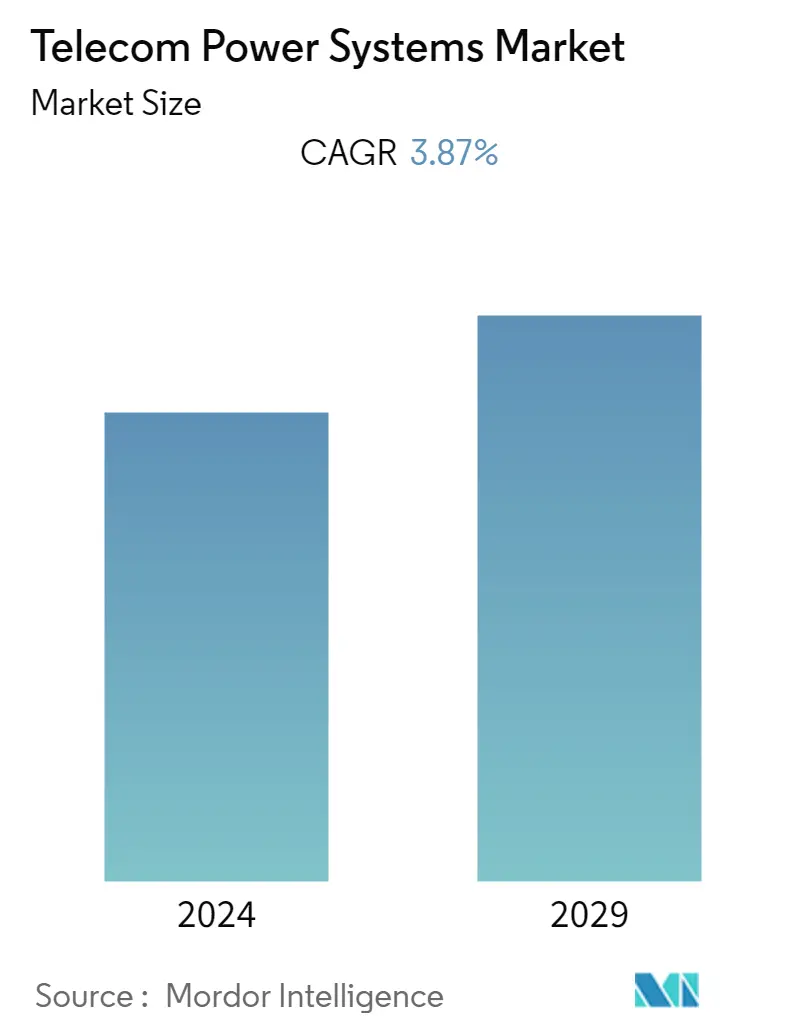Market Size of Telecom Power Systems Industry

| Study Period | 2021 - 2029 |
| Base Year For Estimation | 2023 |
| CAGR | 3.87 % |
| Fastest Growing Market | Asia-Pacific |
| Largest Market | North America |
| Market Concentration | Low |
Major Players
*Disclaimer: Major Players sorted in no particular order |
Telecom Power Systems Market Analysis
The telecom power systems market is expected to register a CAGR of 3.87% over the forecast period. The COVID-19 pandemic led to the growth of broadband traffic, which led to several infrastructure expansion plans by the telecom industry. According to a survey by the GSMA, UK operator BT reported a 100% increase in daytime traffic across its fixed broadband network. Mobile data traffic has declined slightly since before the virus as more people connect to Wi-Fi. On similar lines, Telefonica reported a 35% data increase over its networks in Spain.
- Telecom power systems comprise rectifiers, batteries, and a power system controller, and they secure telecommunication services in case of grid power interruptions and fluctuations. The telecom power systems market has been mostly driven by the fact that more towers are being put up in different parts of the world. This is due to a number of factors, including changing technologies.
- The increasing need for tower installations is driving the market as the following technologies, such as 4G and 5G, are being deployed. Still, the coverage is relatively lower for 4G and 5G technologies in various regions, so telecom companies need to set up more towers to handle the growing voice and data traffic. As technology improves, so does people's need for speed. At first, speed would vary because there wasn't enough coverage, but that's changing now.
- Using solar energy is a steady method of providing electrical power to telecommunication systems in remote places beyond the main electricity grid, for instance, on mountaintops and vast swamps where power is unavailable or it is impractical to install new power lines. This deployment may become a future trend in this market.
- Power outages, especially in developing economies, have been a major roadblock to adopting the latest access technologies. This problem has irritated service providers, cell site operators, and owners all over the world. A new GSMA study says that there could be more than 50 million 5G connections in the MENA region by 2025 and that about 30% of the region's population will be covered by 5G networks by that time.
- Additionally, renewable energy sources for remote telecommunication systems have become more popular recently due to technological advancements and lower costs. Renewable resources, like the wind and the sun, provide useful energy, lower the overall costs of running the system's infrastructure, and leave less of a carbon footprint.
The COVID-19 pandemic also led to the growth of broadband traffic, leading to several infrastructure expansion plans by the telecom industry. According to the International Telecommunication Union (ITU), the increase in traffic due to the COVID-19 pandemic resulted in an acceleration of capital expenditure (CAPEX) via the expansion of capacity (i.e., operations and maintenance CAPEX). The increased capital expenditure has led to a need for new power systems.
Telecom Power Systems Industry Segmentation
Telecom power systems provide stable telecommunication services in the event of grid power interruptions and fluctuations. These systems are designed for wireless broadband access, fixed-line applications, the Internet backbone, and data centers. The power system can be expanded with renewable energy sources, which creates major energy and operating cost savings that can further increase market growth.
The market study analyzes the market trends and opportunities for different types of power ranges, such as low, medium, and high, used in various end-user industry applications. These pieces of equipment find applications in the process and manufacturing industries, among others. Furthermore, the study examines the impact of COVID-19 on market participants and stakeholders throughout the supply chain.
The market sizes and forecasts are provided in terms of value (USD million) for all the above segments.
| By Power Range | |
| Low | |
| Medium | |
| High |
| By End-user Application | |
| Access | |
| Core | |
| Metro |
| By Geography | |
| North America | |
| Europe | |
| Asia Pacific | |
| Latin America | |
| Middle East and Africa |
Telecom Power Systems Market Size Summary
The telecom power systems market is poised for growth, driven by the increasing demand for infrastructure to support advanced communication technologies like 4G and 5G. These systems, which include rectifiers, batteries, and power system controllers, are essential for maintaining telecommunication services during power interruptions. The expansion of mobile towers globally, fueled by the need for enhanced coverage and speed, is a significant factor propelling the market. The COVID-19 pandemic accelerated broadband traffic growth, prompting telecom companies to invest in infrastructure expansion, thereby increasing the demand for robust power systems. Additionally, the adoption of renewable energy sources, such as solar and wind power, is gaining traction as a sustainable solution for powering remote telecommunication systems, further influencing market dynamics.
The market landscape is characterized by technological advancements and increased competition, with key players like Eaton Corporation, Huawei Technologies Co., and Cummins Inc. leading the charge. The integration of new technologies such as network function virtualization (NFV) and software-defined networking (SDN) is enhancing network efficiency and performance, which in turn drives the need for more telecom power systems. North America, with its early adoption of new technologies, is a significant market, with a high penetration of mobile subscriptions and substantial investments in 5G infrastructure. The fragmented nature of the market, especially with the introduction of 4G LTE systems, is expected to see more players entering, intensifying competition. Collaborative efforts, such as the partnership between Telecom Egypt and Grid Telecom, aim to strengthen telecom infrastructure, highlighting the ongoing developments in the sector.
Telecom Power Systems Market Size - Table of Contents
-
1. MARKET INSIGHTS
-
1.1 Market Overview
-
1.2 Industry Value Chain Analysis
-
1.3 Industry Attractiveness - Porter's Five Forces Analysis
-
1.3.1 Threat of New Entrants
-
1.3.2 Bargaining Power of Buyers
-
1.3.3 Bargaining Power of Suppliers
-
1.3.4 Threat of Substitute Products
-
1.3.5 Intensity of Competitive Rivalry
-
-
1.4 Impact of COVID-19 on the Market
-
-
2. MARKET SEGMENTATION
-
2.1 By Power Range
-
2.1.1 Low
-
2.1.2 Medium
-
2.1.3 High
-
-
2.2 By End-user Application
-
2.2.1 Access
-
2.2.2 Core
-
2.2.3 Metro
-
-
2.3 By Geography
-
2.3.1 North America
-
2.3.2 Europe
-
2.3.3 Asia Pacific
-
2.3.4 Latin America
-
2.3.5 Middle East and Africa
-
-
Telecom Power Systems Market Size FAQs
What is the current Telecom Power Systems Market size?
The Telecom Power Systems Market is projected to register a CAGR of 3.87% during the forecast period (2024-2029)
Who are the key players in Telecom Power Systems Market?
Eaton Corporation, Huawei Technologies Co., Cummins Inc., ZTE Corporation and Efore Group are the major companies operating in the Telecom Power Systems Market.

